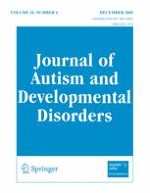01-12-2005
Spatial Cognition in Autism Spectrum Disorders: Superior, Impaired, or Just Intact?
Gepubliceerd in: Journal of Autism and Developmental Disorders | Uitgave 6/2005
Log in om toegang te krijgenAbstract
The profile of spatial ability is of interest across autism spectrum disorders (ASD) because of reported spatial strengths in ASD and due to the recent association of Asperger’s syndrome with Nonverbal Learning Disability. Spatial functions were examined in relation to two cognitive theories in autism: the central coherence and executive function (EF) theories. Performance on spatial tasks, EFs, and global/local processing was compared in children with ASD and controls. While the ASD group had faster reaction times on the Embedded Figures task, spatial performance was intact, but not superior, on other tasks. There was no evidence for impairments in EF or in processing global/local information, therefore contradicting these two theories. The implications of these results for these two theories are discussed.
